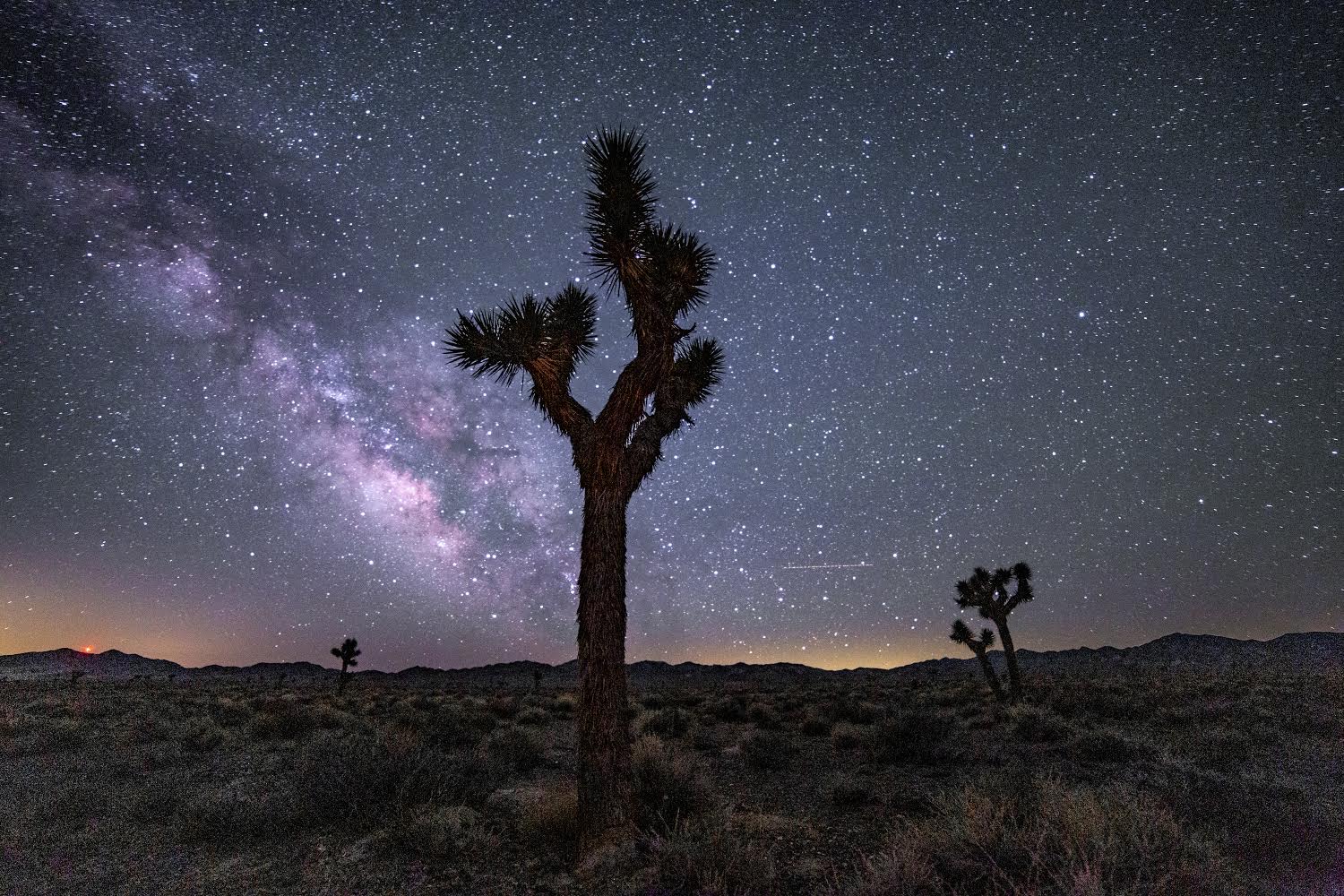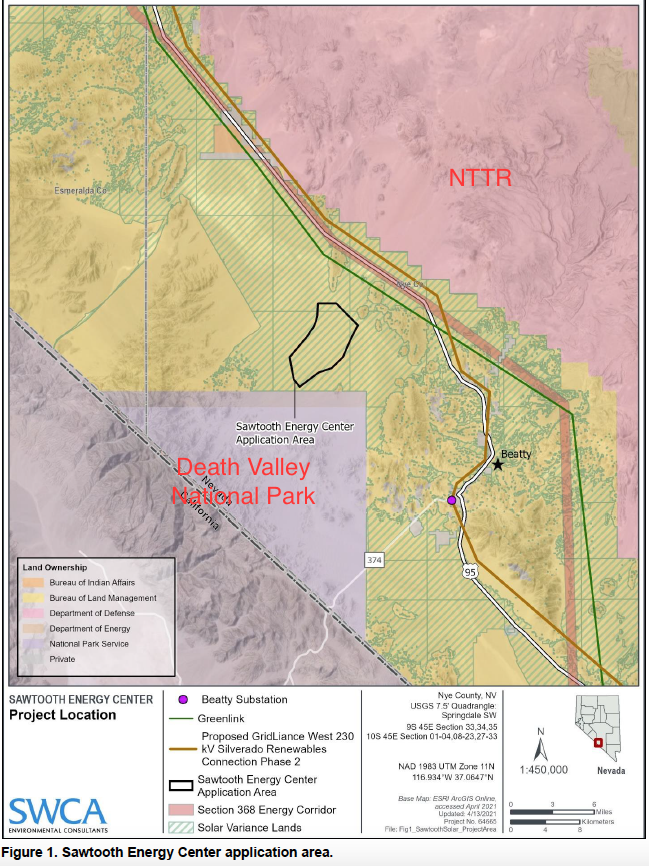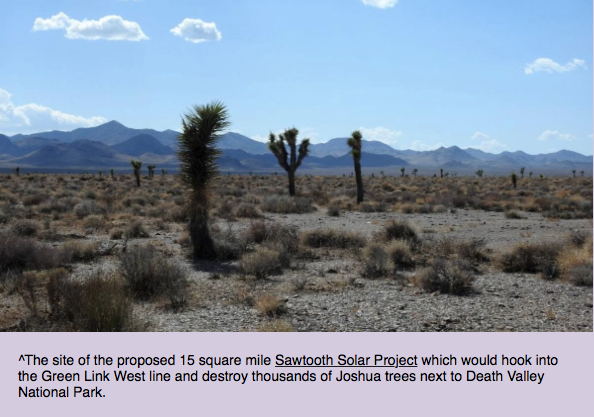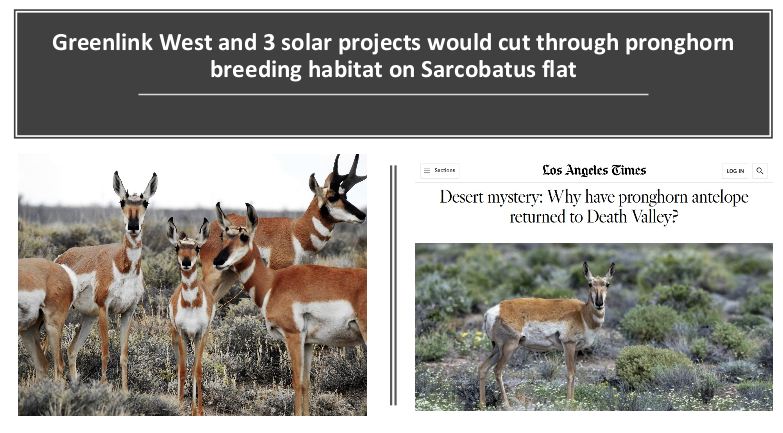Sawtooth Energy Center Project
Massive Utility-scale Solar Project Would Mar Dark Night Skies Next to Death Valley National Park

^The Milky Way on the site of the proposed massive Sawtooth solar project in Sarcobatus Flat, Nevada. Photo: Justin McAfee.
10,000-acre solar sprawl on public lands.
June 20, 2021 - Sarcobatus Flat, NV - Tonopah Bureau of Land Management Field Office -
Boulevard Associates, a subsidiary of NextEra Energy is proposing to construct a huge 1,000-megawatt photovoltaic project in a remote basin next to the "Nevada Triangle" portion of Death Valley National Park, north of Beatty, Nye County, Nevada. Approximately 10,000 acres would be required, on public lands with pristine northern Mojave Desert Scrub and transitional desert habitat between to Grapevine Mountains in the westand hills next to the Nevada Test and Training Range to the east. NextEra is the developer of the approved Yellow Pine Solar Project in Pahrump Valley, NV, under construction.
Where is this "Smart From the Start" push we keep hearing about during the last 10 years.
Why is such a giant solar project proposed for a remote desert basin hundreds of miles from load centers? There is nothing out here but wildlands, herds of antelope, desert horned lizards, wildflower fields, vast natural vistas, open public lands, and fantastic star-watching.
No transmission infrastructure exists here, thus protecting these remote basins and ridges from development.
So NextEra is proposing an approximately 17-mile-long 230 kilovolt (kV) generation tie-in (gen-tie) line that would extend from an on-site project substation through Bureua of Land Management (BLM) land to the Valley Electric Association (VEA) Beatty substation. Alternatively, the project may interconnect to NV Energy’s fast-tracked 525 kV Greenlink West transmission line through a new tie-in facility or GridLiance West’s proposed 230 kV Silverado Renewables Connection Phase 2 transmission line that would run parallel to Greenlink. Gen-tie line alignment options are currently under development.

^Proposed Sawtooth Solar Project, and proposed long high-voltage transmission lines in order to access these remote desert ecosystems and public lands.
The proposed solar project would be on BLM land that is identified as variance lands in the Final Solar Energy Development Programmatic Environmental Impact Statement (BLM 2012). That Solar Energy Zoning process sure was a waste of time. Solar developers apparently want all other public lands except the Solar Energy Zones. We will be requestiong a special Variance merting with the BLM.
In its Plan of Development submitted to BLM, NextEra disregards any consideration of proximity to Death Valley National Park, biological resources, archaeology, rare plants, antelope fawning grounds, federally threatened Mojave desert tortoise, and dark night skies, and only considers it own narrow interests of flat land with nearness to proposed transmission infrastructure:
PROPOSED PROJECT SETTING
The location of the Proposed Project has been selected because it provides a large, flat portion of land suitable for solar development near the NV Energy GreenLink transmission line as well as a the VEA Beatty substation and GridLiance’s West proposed 230 kV Silverado Renewables Phase 2 transmission line. Using the BLM Solar Energy Environmental Mapper (https://bogi.evs.anl.gov/solmap/portal/), the land is identified as available solar variance land with strong solar potential (BLM 2012). There is also a BLM Section 368 corridor approximately 3.5 miles to the east of the site.
The developer says the need for this solar project is simply deliver renewable energy into the Nevada energy grid and support the state's RPS goal (50% by 2030). There is never any discussion of using brownfields, already-disturbed land, or Distributed Energy Resources such as rooftop and carport solar systems, demand response grid management, energy efficiency and energy conservation.
![]()
NextEra is proposing to use single-axis tracking panels. The solar project would be surrounded by a 6 to 7-foot-tall chainlink security fence topped with barbed wire. This would cut off public access to 10,000 acres of land. Security night-lighting would also be installed, and even though lights would be directed downwards, the light pollution would mar dark night skies.
Energy storage would use Lithium-ion battery banks housed in 40-foot-long buildings similar to shipping containers, throughout the solar fields. These Lithium-ion battery bank buildings along would scrape 50 acres of desert shrubland, as they need to be set on cement pads. A battery supplier has not been selected at this time due to changing markets; however, past suppliers have included LG Chem, Samsung, BMW, Tesla, and Lishen.
There are realtively few dirt roads in Sarcobarus Flat, yet an untold number of new access roads would need to be bulldozed into the desert to build the project and maintain it: internal access roads to the on-site substation, switching station, and energy storage system would consist of 20-foot-wide roads with compacted gravel or dirt. Internal maintenance pathways between solar modules would be approximately 16 feet wide.
Traffic: For a 1,000-MW project, the peak daily construction employees would be approximately 800 daily. In addition to the approximately 800 maximum daily workers traveling to the site, there would be up to 50 truck trips per day at peak construction activity (when trenching and system installation phases overlap). A total of up to 850 trips per day are anticipated during peak construction activities, assuming a worst-case scenario whereby no carpooling occurs. The majority of the truck deliveries would be for the PV system installation and any aggregate material that may be required for road base.
The heaviest delivery loads to the site would consist of the tracker structures, rock truck deliveries, and the generator step up. These loads would typically be limited to a total weight of 80,000 pounds, with a cargo load of approximately 25 tons or 50,000 pounds of rock or tracker structures. The generator step up could be up to 160,000 pounds. Typically, the rock is delivered in “bottom dump trucks” or “transfer trucks” with six axles and the tracker structures would be delivered on traditional flatbed trucks with a minimum of five axles. Low-bed transport trucks would transport the construction equipment to the site as needed. The size of the low-bed truck (number of axles for weight distribution) would depend on the equipment transported. What will this do to delicate nests of ground-nesting birds such as horned larks? Or the numerous Desert horned lizards that occupy the site?
Water Use: Water consumption during construction would be utilized for dust suppression and earthwork over an approximately 48-month period. Panel rinsing is expected to be conducted up to four times annually as performance testing and weather and site conditions dictate. Construction water and operational water would either come from drilling a well on site or trucking in water from a nearby source. If groundwater proves unsuitable for washing, water trucks would be used to deliver water from a local purveyor.
Construction Activities: Prior to initiation of grading operations, the construction areas will be cleared and grubbed of vegetation and miscellaneous debris. The primary grading activities will be associated with the development of access roads, with lesser quantities associated with the Project substation, and the associated foundations. For these areas, grading will consist of the excavation and compaction of earth to meet the design requirements. Grading within the solar field will match existing grades as close as possible. The existing contours will need to be smoothed out to remove existing washes for access purposes.
Apparently mowing will not take place on this project, but 10,000 acres of intact healthy desert shrub ecosystem would be graded with heavy machinery and all vegetation removed, including Western Joshua trees. How is this gree?
Western Joshua Trees

Pronghorn Antelope Habitat

Fawning ground in Sarcobatus Flat.
HOME.........Death Valley Solar Projects.....Beatty Solar Energy Center.....Greenlink Transmission Lines
